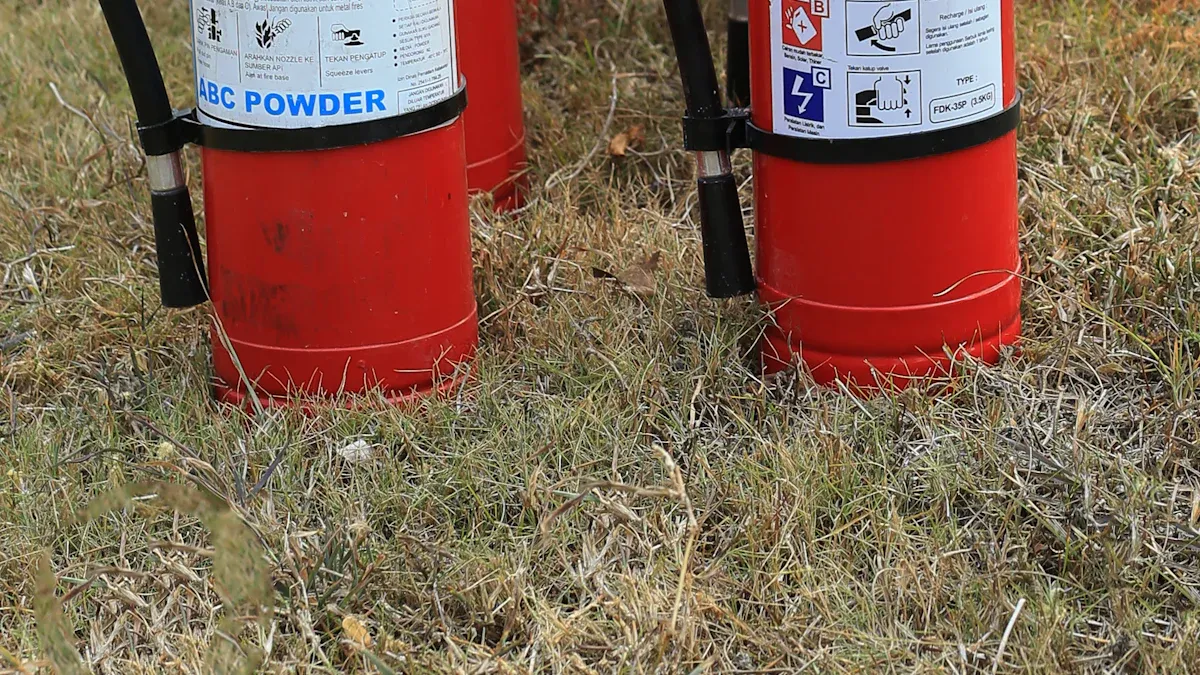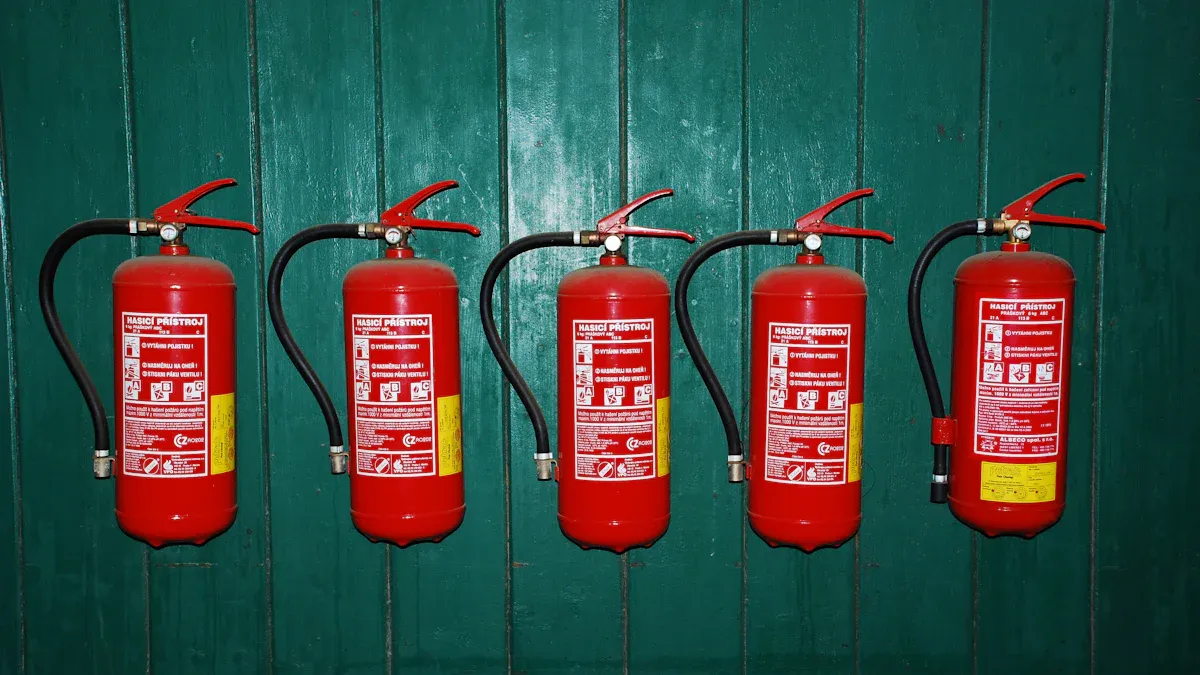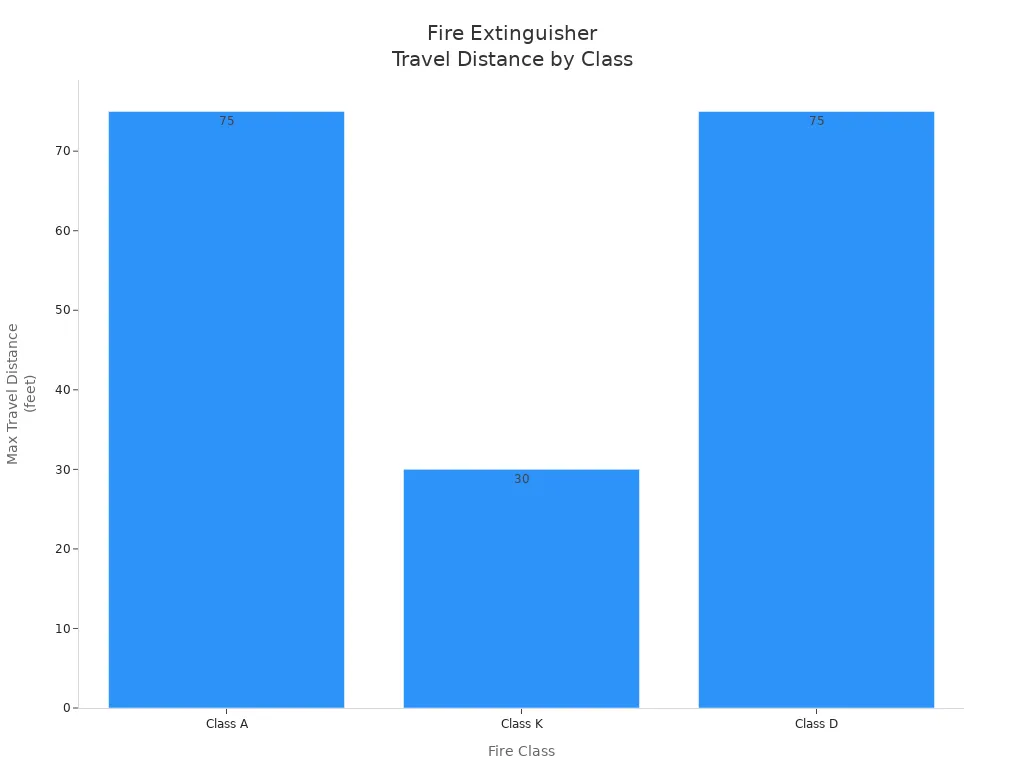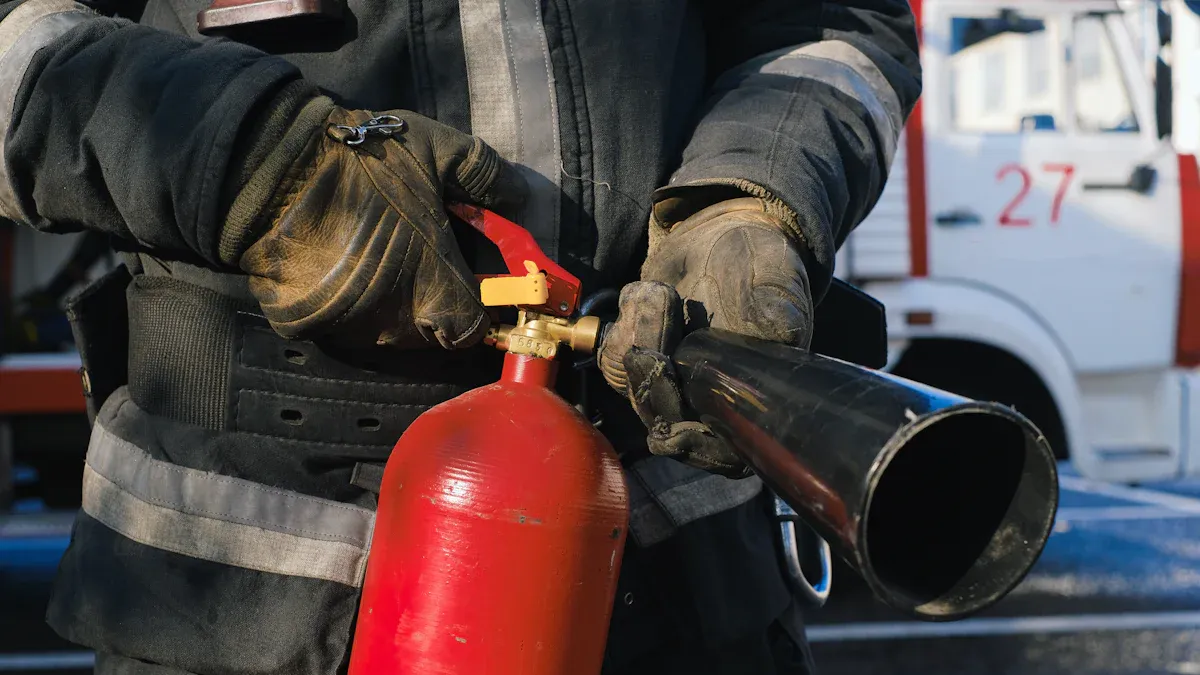
Fire safety experts emphasize the importance of choosing the right fire extinguisher for each risk. Water, Foam water extinguisher, Dry powder extinguisher, wet type fire hydrant, and lithium-ion battery models address unique hazards. Annual incident reports from official sources highlight the need for updated technology and targeted solutions in homes, workplaces, and vehicles.
Fire Extinguisher Classes Explained
Fire safety standards divide fires into five main classes. Each class describes a specific type of fuel and requires a unique fire extinguisher for safe and effective control. The table below summarizes the official definitions, common fuel sources, and recommended extinguishing agents for each class:
| Fire Class | Definition | Common Fuels | Identification | Recommended Agents |
|---|---|---|---|---|
| Class A | Ordinary combustibles | Wood, paper, cloth, plastics | Bright flames, smoke, ash | Water, Foam, ABC dry chemical |
| Class B | Flammable liquids/gases | Gasoline, oil, paint, solvents | Rapid flames, dark smoke | CO2, Dry chemical, Foam |
| Class C | Energized electrical equipment | Wiring, appliances, machinery | Sparks, burning smell | CO2, Dry chemical (non-conductive) |
| Class D | Combustible metals | Magnesium, titanium, sodium | Intense heat, reactive | Specialized dry powder |
| Class K | Cooking oils/fats | Cooking oils, grease | Kitchen appliance fires | Wet chemical |
Class A – Ordinary Combustibles
Class A fires involve materials like wood, paper, and cloth. These fires leave behind ash and embers. Water-based fire extinguishers and multipurpose dry chemical models work best. Homes and offices often use ABC fire extinguishers for these risks.
Class B – Flammable Liquids
Class B fires start with flammable liquids such as gasoline, oil, and paint. These fires spread quickly and produce thick smoke. CO2 and dry chemical fire extinguishers are most effective. Foam agents also help by preventing re-ignition.
Class C – Electrical Fires
Class C fires involve energized electrical equipment. Sparks and a burning electrical smell often signal this type. Only non-conductive agents like CO2 or dry chemical fire extinguishers should be used. Water or foam can cause electric shock and must be avoided.
Class D – Metal Fires
Class D fires occur when metals like magnesium, titanium, or sodium ignite. These fires burn very hot and react dangerously with water. Specialized dry powder fire extinguishers, such as those using graphite or sodium chloride, are approved for these metals.
Class K – Cooking Oils and Fats
Class K fires happen in kitchens, often involving cooking oils and fats. Wet chemical fire extinguishers are designed for these fires. They cool and seal the burning oil, preventing re-ignition. Commercial kitchens require these extinguishers for safety.
Essential Fire Extinguisher Types for 2025

Water Fire Extinguisher
Water fire extinguishers remain a staple in fire safety, especially for Class A fires. These extinguishers cool and soak burning materials like wood, paper, and cloth, stopping the fire from reigniting. People often choose water extinguishers for homes, schools, and offices because they are cost-effective, easy to use, and environmentally friendly.
| Aspect | Details |
|---|---|
| Primary Effective Fire Class | Class A fires (ordinary combustibles like wood, paper, cloth) |
| Advantages | Cost-effective, easy to use, non-toxic, environmentally friendly, effective for common Class A fires |
| Limitations | Not suitable for Class B (flammable liquids), Class C (electrical), Class D (metal) fires; can freeze in cold environments; may cause water damage to property |
Note: Never use a water fire extinguisher on electrical or flammable liquid fires. Water conducts electricity and can spread burning liquids, making these situations more dangerous.
Foam Fire Extinguisher
Foam fire extinguishers provide versatile protection for both Class A and Class B fires. They work by covering the fire with a thick foam blanket, cooling the surface and blocking oxygen to prevent re-ignition. Industries such as oil, gas, and petrochemicals rely on foam extinguishers for their ability to handle flammable liquid fires. Many garages, kitchens, and industrial facilities also use foam extinguishers for mixed fire risks.
- Quick fire suppression and reduced burn-back time
- Environmentally improved foam agents
- Suitable for areas where fuels or oils are stored
Foam extinguishers have gained popularity in 2025 due to their improved environmental profiles and effectiveness in industrial and residential settings.
Dry Chemical (ABC) Fire Extinguisher
Dry chemical (ABC) fire extinguishers stand out as the most widely used type in 2025. Their active ingredient, monoammonium phosphate, allows them to tackle Class A, B, and C fires. This powder smothers flames, interrupts the combustion process, and forms a protective layer to prevent re-ignition.
| Fire Extinguisher Type | Usage Contexts | Key Features and Drivers | Market Share / Growth |
|---|---|---|---|
| Dry Chemical | Residential, Commercial, Industrial | Versatile for Class A, B, C fires; mandated by OSHA and Transport Canada; used in 80%+ of U.S. commercial establishments | Dominant type in 2025 |
Dry chemical extinguishers offer a reliable, all-in-one solution for homes, businesses, and industrial sites. However, they are not suitable for kitchen grease fires or metal fires, where specialized extinguishers are required.
CO2 Fire Extinguisher
CO2 fire extinguishers use carbon dioxide gas to put out fires without leaving any residue. These extinguishers are ideal for electrical fires and sensitive environments like data centers, laboratories, and healthcare facilities. CO2 extinguishers work by displacing oxygen and cooling the fire, making them effective for Class B and Class C fires.
- No residue, safe for electronics
- Fast-growing market segment due to increased digital infrastructure
Caution: In enclosed spaces, CO2 can displace oxygen and create a suffocation hazard. Always ensure proper ventilation and avoid prolonged use in confined areas.
Wet Chemical Fire Extinguisher
Wet chemical fire extinguishers are designed for Class K fires, which involve cooking oils and fats. These extinguishers spray a fine mist that cools the burning oil and creates a soapy layer, sealing the surface and preventing re-ignition. Commercial kitchens, restaurants, and food processing facilities depend on wet chemical extinguishers for reliable protection.
- Effective for deep fat fryers and commercial cooking equipment
- Required by safety codes in many food service environments
Dry Powder Fire Extinguisher
Dry powder fire extinguishers offer broad protection for Class A, B, and C fires, as well as some electrical fires up to 1000 volts. Specialist dry powder models can also handle metal fires (Class D), making them essential in industrial settings.
- Recommended for garages, workshops, boiler rooms, and fuel tankers
- Not suitable for kitchen grease fires or high-voltage electrical fires
Tip: Avoid using dry powder extinguishers in enclosed spaces, as the powder can reduce visibility and pose inhalation risks.
Lithium-ion Battery Fire Extinguisher
Lithium-ion battery fire extinguishers represent a major innovation for 2025. With the rise of electric vehicles, portable electronics, and renewable energy storage, lithium-ion battery fires have become a significant concern. New extinguishers feature proprietary water-based, non-toxic, and environmentally friendly agents. These models respond rapidly to thermal runaway, cool adjacent battery cells, and prevent re-ignition.
- Compact and portable designs for homes, offices, and vehicles
- Engineered specifically for lithium-ion battery fires
- Immediate suppression and cooling capabilities
The latest lithium-ion battery technology includes built-in fire suppression features, such as flame-retardant polymers that activate at high temperatures, offering enhanced safety and stability.
How to Choose the Right Fire Extinguisher
Assessing Your Environment
Selecting the right fire extinguisher starts with a careful look at the environment. People should identify fire hazards such as electrical equipment, cooking areas, and storage of flammable materials. They need to check the condition of safety equipment and make sure alarms and exits work well. Building layout affects where to place extinguishers for quick access. Regular reviews and updates help keep fire safety plans effective.
Matching Fire Extinguisher to Fire Risk
Matching the extinguisher to the fire risk ensures the best protection. The following steps help guide the selection process:
- Identify the types of fires likely to occur, such as Class A for combustibles or Class K for kitchen oils.
- Use multipurpose extinguishers in areas with mixed risks.
- Choose specialized models for unique hazards, like clean agent units for server rooms.
- Consider the size and weight for easy handling.
- Place extinguishers near high-risk spots and keep them visible.
- Balance cost with safety needs.
- Train everyone on proper use and emergency plans.
- Schedule regular maintenance and inspections.
Considering New Risks and Standards
Fire safety standards in 2025 require compliance with NFPA 10, NFPA 70, and NFPA 25. These codes set rules for selection, installation, and maintenance. Extinguishers must be easy to reach and placed within the correct travel distance from hazards. New risks, such as lithium-ion battery fires, call for updated extinguisher types and regular staff training.

Home, Workplace, and Vehicle Needs
Different settings have unique fire risks. Homes need dry chemical extinguishers near exits and garages. Workplaces require models based on hazard types, with special units for kitchens and IT rooms. Vehicles should carry Class B and C extinguishers to handle flammable liquids and electrical fires. Regular checks and proper placement help ensure safety everywhere.
How to Use a Fire Extinguisher

The PASS Technique
Fire safety experts recommend the PASS technique for operating most extinguishers. This method helps users act quickly and correctly during emergencies. The PASS steps apply to all extinguisher types, except cartridge-operated models, which need an extra activation step before starting.
- Pull the safety pin to break the seal.
- Aim the nozzle at the base of the fire.
- Squeeze the handle evenly to release the agent.
- Sweep the nozzle side to side across the fire’s base until the flames disappear.
People should always read the instructions on their fire extinguisher before an emergency. The PASS technique remains the standard for safe and effective use.
Safety Tips
Proper use and maintenance of extinguishers protect lives and property. Fire safety reports highlight several important tips:
- Inspect extinguishers regularly to ensure they work when needed.
- Keep extinguishers in visible and accessible locations.
- Mount units securely for quick access.
- Use the correct extinguisher type for each fire hazard.
- Never remove or damage labels and nameplates, as they provide critical information.
- Know the escape route before fighting a fire.
Tip: If the fire grows or spreads, evacuate immediately and call emergency services.
These steps help everyone respond safely and confidently during a fire emergency.
Fire Extinguisher Maintenance and Placement
Regular Inspection
Routine inspection keeps fire safety equipment ready for emergencies. Monthly visual checks help spot damage, confirm pressure levels, and ensure easy access. Annual professional inspections verify full functionality and compliance with OSHA 29 CFR 1910.157(e)(3) and NFPA 10 standards. Hydrostatic testing intervals depend on extinguisher type, ranging from every 5 to 12 years. These inspection schedules apply to both homes and businesses.
- Monthly visual inspections check for damage, pressure, and accessibility.
- Annual professional maintenance confirms compliance and performance.
- Hydrostatic testing occurs every 5 to 12 years, based on extinguisher type.
Servicing and Replacement
Proper servicing and timely replacement protect lives and property. Monthly checks and annual maintenance meet NFPA 10 standards. Internal maintenance is required every six years. Hydrostatic testing intervals vary by extinguisher type. OSHA rules require records of servicing and employee training. Immediate replacement is necessary if rust, corrosion, dents, broken seals, illegible labels, or damaged hoses appear. Pressure gauge readings outside normal ranges or repeated pressure loss after maintenance also signal the need for replacement. Extinguishers made before October 1984 must be removed to meet updated safety standards. Professional servicing and documentation ensure legal compliance.
Strategic Placement
Strategic placement ensures quick access and effective fire response. Mount extinguishers with handles between 3.5 and 5 feet from the floor. Keep units at least 4 inches off the ground. Maximum travel distances vary: 75 feet for Class A and D fires, 30 feet for Class B and K fires. Place extinguishers near exits and high-risk areas, such as kitchens and mechanical rooms. Avoid placing units too close to fire sources. Mount extinguishers near doors in garages to prevent obstruction. Distribute units in common areas with high foot traffic. Use clear signage and keep access unobstructed. Match extinguisher classes to specific risks in each area. Regular assessments maintain proper placement and compliance with OSHA, NFPA, and ADA standards.
Tip: Proper placement reduces retrieval time and increases safety during emergencies.
- Every environment needs the right fire extinguisher for its unique risks.
- Regular reviews and updates keep safety plans effective.
- New standards in 2025 highlight the need for certified equipment and smart technology.
Staying informed about fire risks ensures better protection for everyone.
FAQ
What is the best fire extinguisher for home use in 2025?
Most homes use an ABC dry chemical extinguisher. It covers ordinary combustibles, flammable liquids, and electrical fires. This type offers broad protection for common household risks.
How often should someone inspect a fire extinguisher?
Experts recommend monthly visual checks and annual professional inspections. Regular maintenance ensures the extinguisher works during emergencies and meets safety standards.
Can one fire extinguisher handle all types of fires?
No single extinguisher handles every fire. Each type targets specific hazards. Always match the extinguisher to the fire risk for maximum safety.
Tip: Always read the label before use. Proper selection saves lives.
Post time: Aug-13-2025

